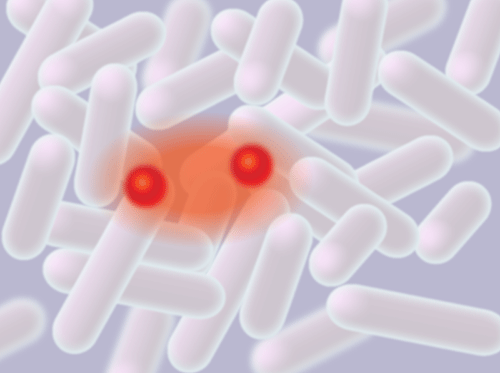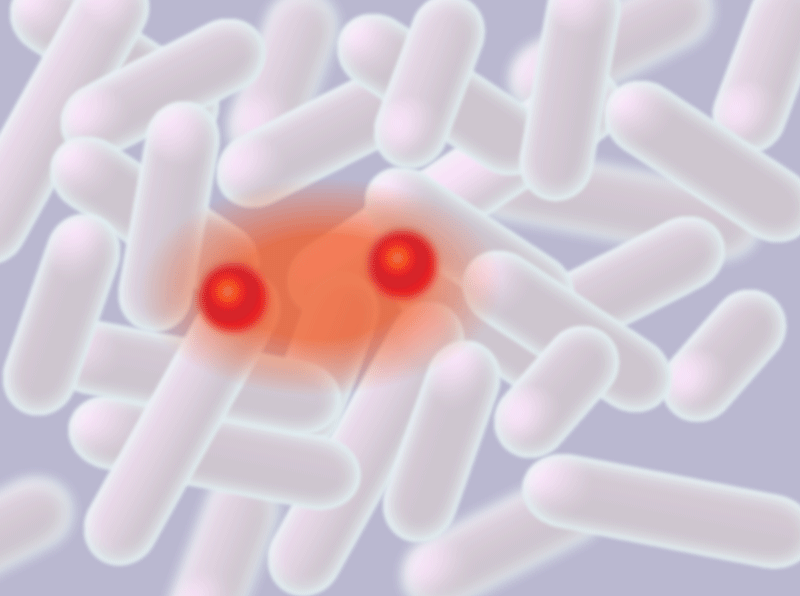Giant Molecule Made from Two Atoms
Strongly bound diatomic molecules such as or are less than a nanometer across. Surprisingly, scientists have been able to create two-atom molecules more than a thousand times larger by using exotic atoms that attract one another only very weakly. Now, a pair of physicists have calculated what makes these “macrodimers” stable, and they have verified their predictions by creating micrometer-sized molecules containing two cesium atoms. The macrodimers could have applications in quantum computing.
Interest in these macromolecules stems from the challenges they pose to conventional understanding of molecules and bonds. More than a decade ago, physicists predicted that molecules with interatomic distances as large as 1 micrometer might be created by using a pair of atoms in so-called Rydberg states. These are atoms in which a single outer-shell electron has been excited to a high quantum state so that it orbits far away from the nucleus. Although Rydberg atoms are unstable, they can live as long as tens of microseconds, and experimenters have succeeded in creating macrodimers from them, confirming their existence indirectly by destroying them and detecting specific spectroscopic signatures [1].
However, physicists Heiner Saßmannshausen and Johannes Deiglmayr of the Swiss Federal Institute of Technology (ETH) in Zurich, Switzerland, say that the earlier theoretical argument for the existence of macrodimers included some significant assumptions. To examine the argument more rigorously, they developed a sophisticated model of the interaction of Rydberg atoms and used it to predict in more detail the properties of stable macrodimers, such as the amount of energy binding them together. They then tested their model by creating the predicted molecules.
The physicists performed detailed quantum calculations of the force between two cesium atoms in specified Rydberg states. The interatomic force could be attractive or repulsive, they found, depending on the distance between the atoms. For some pairings of Rydberg atoms, the force vanished at certain distances, meaning that the two atoms could remain at rest in the form of a macrodimer with an expected lifetime of some tens of microseconds.
For their experimental studies, Saßmannshausen and Deiglmayr chose a stable macrodimer consisting of cesium atoms with electrons in the 43rd and 44th excited energy levels. They began with an ultracold gas of cesium atoms with average separation about 1 micrometer—roughly the size of the macrodimer they wanted to make. They used a pulse of laser light to excite a small fraction of these atoms into the 44th Rydberg state. They then pulsed the gas with a second laser whose energy was less, by an amount delta, than the energy needed to excite cesium atoms into the 43rd Rydberg state. The value of delta represents the so-called binding energy of the macrodimer and is the amount by which a pair of cesium atoms in the 43rd and 44th Rydberg states can reduce their total energy by joining together as a macrodimer.
To verify that this procedure indeed created a few macrodimers, Saßmannshausen and Deiglmayr detected ions created when one of the atoms in a macrodimer decayed to a lower Rydberg state, releasing energy that ionized the other atom. The physicists found strong signals for several values of delta, each one corresponding to the binding energy of a distinct macrodimer state predicted by their calculations.
“Our model showed that many of the macrodimer states predicted earlier do not exist,” says Deiglmayr, “but that other macrodimer states should exist.” The direct measurement of the macrodimers’ binding energies, he adds, goes beyond previous work in establishing the reality of these unusual states.
As Deiglmayr points out, other physicists have already proposed using Rydberg macrodimers as the basis of logical gates in a quantum computer. If two quantum bits (qubits) were encoded in the states of a pair of Rydberg atoms constituting a macrodimer, the absence of any force between the atoms could improve the precision of operations carried out jointly on those qubits.
“This work really goes a long way towards providing an understanding of macrodimers,” says James Shaffer of the University of Oklahoma in Norman. “I think it will help people trying to design experiments that use these types of atom-atom interactions for quantum optics and other quantum information applications.”
This research is published in Physical Review Letters.
–Mark Buchanan
Mark Buchanan is a freelance science writer who splits his time between Abergavenny, UK, and Notre Dame de Courson, France.
References
- K. R. Overstreet, A. Schwettmann, J. Tallant, D. Booth, and J. P. Shaffer, “Observation of Electric-Field-Induced Cs Rydberg Atom Macrodimers,” Nature Phys. 5, 581 (2009).





